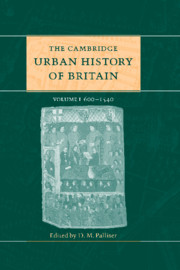Book contents
- Frontmatter
- Part I Introductory
- Part II The early middle ages 600–1300
- 3 General survey 600–1300
- 4 Power and authority 600–1300
- 5 Society and population 600–1300
- 6 The economy of British towns 600–1300
- 7 Churches, education and literacy in towns 600–1300
- 8 The topography of towns 600–1300
- 9 London from the post-Roman period to 1300
- 10 The large towns 600–1300
- 11 Small towns 600–1270
- Part III The later middle ages 1300–1540
- Part IV Regional surveys
- Part V Conclusion
- Appendix: Ranking lists of English medieval towns
- Select bibliography
- Index
- References
7 - Churches, education and literacy in towns 600–1300
from Part II - The early middle ages 600–1300
Published online by Cambridge University Press: 28 March 2008
- Frontmatter
- Part I Introductory
- Part II The early middle ages 600–1300
- 3 General survey 600–1300
- 4 Power and authority 600–1300
- 5 Society and population 600–1300
- 6 The economy of British towns 600–1300
- 7 Churches, education and literacy in towns 600–1300
- 8 The topography of towns 600–1300
- 9 London from the post-Roman period to 1300
- 10 The large towns 600–1300
- 11 Small towns 600–1270
- Part III The later middle ages 1300–1540
- Part IV Regional surveys
- Part V Conclusion
- Appendix: Ranking lists of English medieval towns
- Select bibliography
- Index
- References
Summary
As in many other parts of Europe, churches are often the key to explaining the revival or emergence of towns in Britain in the earlier middle ages; nor did they cease to be influential once the towns were well established, but, on the contrary, continued to dominate many smaller towns, or to be powerful forces in larger ones, as landlords, consumers and patrons of the arts. Not least among the last was architecture: churches were usually the most important features in the landscape, being usually the tallest structures, often topographically the most extensive, and architecturally the most innovative. While defining the role of churches in towns is fairly straightforward in the earlier middle ages, exploring culture is much harder, chiefly because it is difficult to define a specifically urban culture before the end of the thirteenth century. The high culture of courts and major churches did not necessarily require, though it often enjoyed, an urban setting, while popular culture is not only hard to divide into urban and rural forms but is also poorly documented for this period. None the less, it is possible to discern one cultural area where towns played an active role towards the end of this period: that is the growth of literacy and the development of education. Accordingly, this chapter will be broken up into four sections of unequal length: first, a short summary of the role of churches in the embryonic towns of the 600-900 period; secondly, an overview of churches in towns as they expanded or were created in the tenth and eleventh centuries; thirdly, an overview of the diversification of ecclesiastical institutions in towns in the twelfth and thirteenth centuries, and fourthly, a sketch of three separate aspects of urban culture: schools, the increasing use of the written word by townspeople and the development of the genre of urban panegyric.
- Type
- Chapter
- Information
- The Cambridge Urban History of Britain , pp. 127 - 152Publisher: Cambridge University PressPrint publication year: 2000
References
- 3
- Cited by



